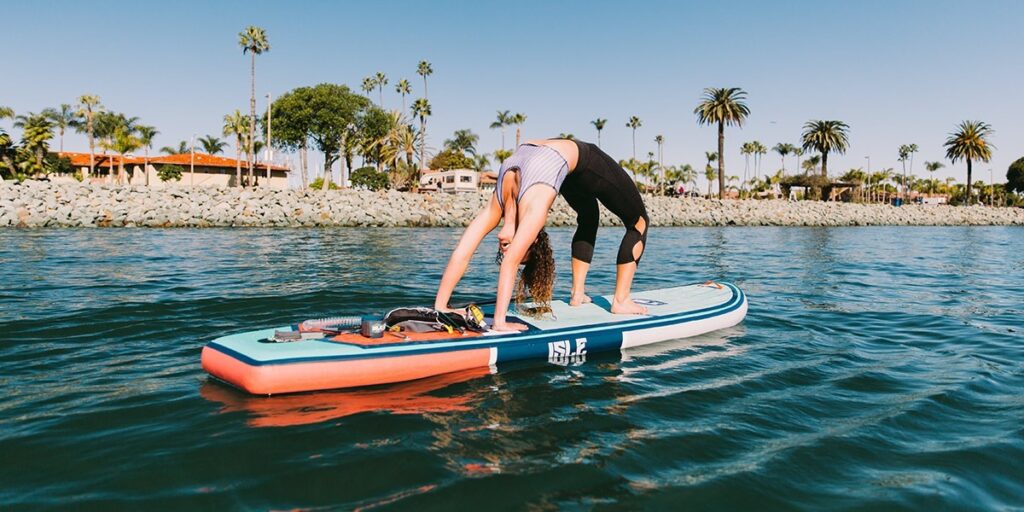Welcome to the world of paddle boarding, where the serene beauty of gliding on water meets the exhilaration of a full-body workout. Paddle boarding isn’t just a leisurely activity; it’s a fantastic way to sculpt your body and boost your fitness. In this guide, we’ll dive into the benefits of turning your SUP (Stand-Up Paddle) experience into a powerhouse workout, blending exercise with the joy of being out on the water.
Benefits of Paddle Boarding for Fitness
Core Strength
Let’s start with the core of the matter – literally. Paddleboarding engages your core muscles like a few other activities. The constant balancing act on the board activates your abdominal, oblique, and lower back muscles, transforming your paddle session into a stealthy core workout. Better balance on the board? Check.
Cardiovascular Health
Paddle boarding isn’t just a scenic glide; it’s a cardio party on the water. The rhythmic paddling elevates your heart rate, giving your cardiovascular system a healthy boost. It’s a workout that doesn’t feel like a workout, and you get to enjoy the fresh air and scenic views while doing it. If you want to buy a board to enjoy cardio, head to TidalRave for quality inflatable SUPs.
Low-Impact Exercise
Say goodbye to joint stress. Paddle boarding is a low-impact exercise, making it gentle on your joints while still providing an effective workout. It’s an ideal option for those looking to stay active without subjecting their joints to the wear and tear of high-impact activities. Your joints will thank you.
Essential Paddle Boarding Fitness Techniques
Paddling Techniques for Intensity
Paddling isn’t just about gliding; it’s about intensity. To ramp up your workout, focus on your paddling techniques. Experiment with faster strokes, alternate sides for an uneven burn, and challenge yourself to maintain a brisk pace. It’s like turbocharging your paddle board for an extra dose of fitness.
Balance Exercises
Balance is the unsung hero of paddle boarding fitness. Engage your core even further by incorporating balance exercises into your paddle routine. Try paddling on one leg, practice yoga poses, or challenge yourself with a few squats. Each wobble is a mini workout for those stabilizing muscles.
Interval Training on the Board
Take your workout up a notch with interval training. Alternate between periods of high-intensity paddling and more relaxed strokes. It’s a simple yet effective way to boost your heart rate, burn more calories, and keep things interesting on the water. High-intensity intervals – the spice of paddle boarding life.
Full-Body Exercises on the Paddle Board
Bodyweight Exercises
Who needs a gym when you have a paddle board? Incorporate bodyweight exercises for a full-body burn. Squats, lunges, and push-ups are your go-to moves. The unstable surface of the board adds an extra layer of challenge, recruiting more muscles for each repetition. Sun, sea, and squats – the perfect trio.
Yoga on the Paddle Board
Elevate your paddle board workout with a touch of zen. Paddle board yoga combines the benefits of strength, flexibility, and mindfulness. From downward dog to warrior pose, each movement engages different muscle groups, creating a harmonious blend of fitness and tranquility. It’s a workout for both body and soul.
Does the Length of Your Paddle Board Matter?
If you’re new to paddleboarding, you might be under the impression that a board is a board. But, this is not quite true. There are many elements of a board that can impact your experience. One of them is the length. This has the ability to affect stability, manoeuvrability, and responsiveness. Thus, if you’re going to be buying your own paddle board, this is a detail you must pay attention to. Here’s what you need to know about the length.
Three Length Types
Typically, most people say that there are three lengths you can choose from when it comes to a paddle board. You’ve got a short, medium and long board. You’ll find that short boards are under 10 feet. Then, you’ve got 10 to 12-foot boards, which can be classed as a medium size. Then, you have the long designs that are over 12 feet. Now, let’s consider them in turn to find the right one for you.
A Short Board
First, let’s start with a short board. Being under 10 feet means that they typically allow more movement and are quicker to respond. So, if you’re going to be surfing or moving around in choppy water and need to make quick decisions, this might be a board that you like. But, you’ll need to be experienced in order to enjoy this type.
A Medium Board
Next, let’s move on to the medium board, which is usually the most popular size. At anywhere from 10 to 12 feet, you can enjoy more stability. This allows beginners to enjoy using this board as they find it easier to balance. It can be used on rivers and lakes when you want to have a fun yet relaxing time. Any experience level can enjoy this board, and it’s versatile to use in various environments.
A Long Board
Then, there is a long board. Again, this can be a good one for beginners. But, it can seem quite big at over 12 feet. Some people prefer this design when they’re covering long distances. It can seem more efficient on the water. If you have a heavier body weight, you might feel more supported on this type of board.
Conclusion
So there you have it – the ultimate guide to turning your paddle boarding experience into a full-body workout. Paddle boarding isn’t just a water activity; it’s a dynamic fitness platform waiting to be explored. Embrace the balance, revel in the movements, and let the gentle splash of the water accompany your journey to a fitter, healthier you.

